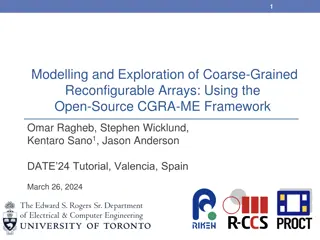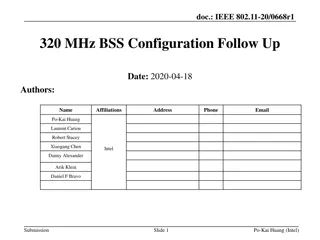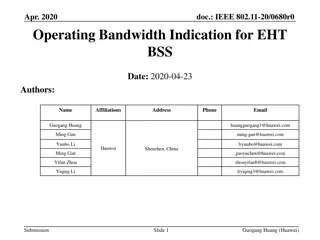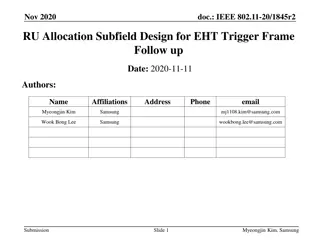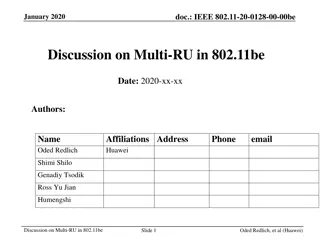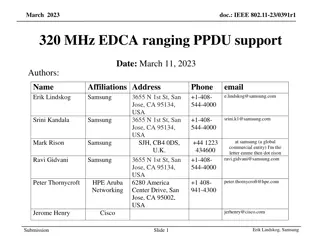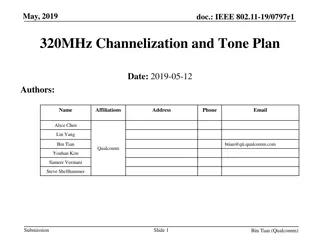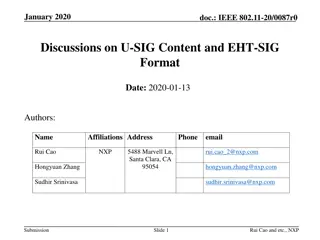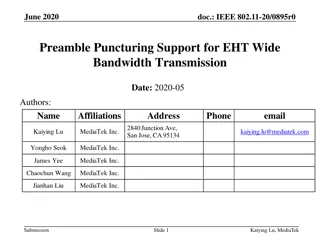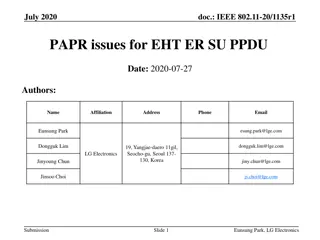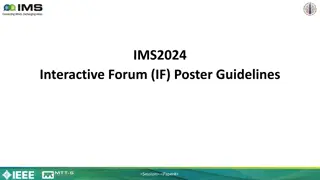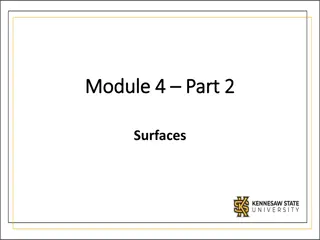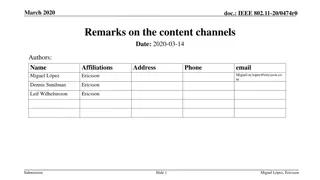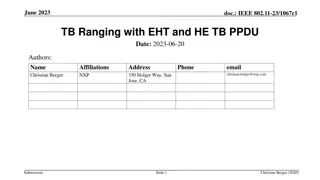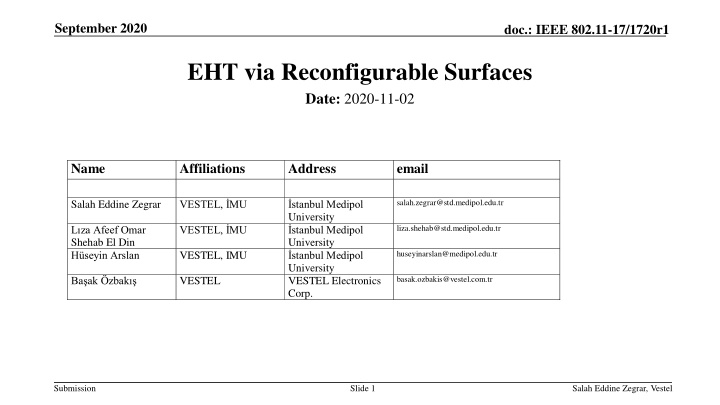
Enhancing Wireless Networks with Reconfigurable Surfaces
Explore the concept of reconfigurable surfaces in wireless communication as a means to improve signal quality, data rate, and coverage. Learn how these surfaces manipulate incident waves, control channel phases, and enhance system performance. Discover the difference between conventional and proposed approaches in 802.11 networks for better connectivity.
Download Presentation

Please find below an Image/Link to download the presentation.
The content on the website is provided AS IS for your information and personal use only. It may not be sold, licensed, or shared on other websites without obtaining consent from the author. If you encounter any issues during the download, it is possible that the publisher has removed the file from their server.
You are allowed to download the files provided on this website for personal or commercial use, subject to the condition that they are used lawfully. All files are the property of their respective owners.
The content on the website is provided AS IS for your information and personal use only. It may not be sold, licensed, or shared on other websites without obtaining consent from the author.
E N D
Presentation Transcript
September 2020 doc.: IEEE 802.11-17/1720r1 EHT via Reconfigurable Surfaces Date: 2020-11-02 Name Affiliations Address email Salah Eddine Zegrar VESTEL, MU salah.zegrar@std.medipol.edu.tr stanbul Medipol University stanbul Medipol University stanbul Medipol University VESTEL Electronics Corp. VESTEL, MU liza.shehab@std.medipol.edu.tr L za Afeef Omar Shehab El Din H seyin Arslan VESTEL, IMU huseyinarslan@medipol.edu.tr Ba ak zbak VESTEL basak.ozbakis@vestel.com.tr Submission Slide 1 Salah Eddine Zegrar, Vestel
September 2020 doc.: IEEE 802.11-17/1720r1 Outline Abstract. An Introduction to reconfigurable surfaces. Conventional 802.11 BSS (dumb). Proposed 802.11 BSS (intelligent). Why 802.11 and reconfigurable surfaces? Feasibility of reconfigurable surfaces in 802.11. Conclusion References Submission Slide 2 Salah Eddine Zegrar, Vestel
September 2020 doc.: IEEE 802.11-17/1720r1 Abstract The wireless channel has been always modeled as a random process, that degrades the quality of the received signal due to the interactions of the electromagnetic waves with the surrounding randomly available objects. Additionally, at high frequencies (above 6 GHz), the transmitted signals become more sensitive to blockage and suffer from sever power degradation. A channel controller, named, reconfigurable surface, is presented here to provide better system performance in term of received signal quality, data rate and coverage. Submission Slide 3 Salah Eddine Zegrar, Vestel
September 2020 doc.: IEEE 802.11-17/1720r1 An Introduction to Reconfigurable Surfaces Reconfigurable surfaces are part of the environment that are capable of manipulating the incident waves to alter the channel realization. These surfaces contain many passive elements, each has determined size, location and complex weight. The ability of controlling the channel is due the ability of controlling the phases of the elements on these surfaces, given by ? matrix. ?1,1 ??,1 ?1,? ??,? ? = Submission Slide 4 Salah Eddine Zegrar, Vestel
September 2020 doc.: IEEE 802.11-17/1720r1 Conventional 802.11 BSS (dumb) Consider one BSS consisting of one AP and one STA, operating at high frequencies. The LoS between the AP and the STA is blocked. The received signal by the STA is weak and the quality is bad due to the multipath. Salah Eddine Zegrar, Vestel Submission Slide 5
September 2020 doc.: IEEE 802.11-17/1720r1 The Proposed 802.11 BSS (intelligent) A surface with the capability of controlling the channel and changing the propagation environment is deployed. The reconfigurable surface provides virtual LoS, expends the coverage area and enhance the quality of the signal received by the STA. The reconfigurable surface is controlled by the AP through a backhaul link. Submission Slide 6 Salah Eddine Zegrar, Vestel
September 2020 doc.: IEEE 802.11-17/1720r1 Why 802.11 and Reconfigurable Surfaces Reconfigurable surfaces have given optimum performance when deployed for indoor application, which is suitable for WiFi systems [1]. Reconfigurable surfaces deployment is a non-expensive effective solution for enlarging the coverage area, rather than implementing multiple APs. Specifically for dense indoor environments. Reconfigurable surfaces deployment can achieve the high requirements of the future WiFi systems such as EHT. Submission Slide 7 Salah Eddine Zegrar, Vestel
September 2020 doc.: IEEE 802.11-17/1720r1 Consideration of reconfigurable surfaces in 802.11 To provide EHT CSI must be very good. To controlling the channel, all multipath can be aligned constructively to boost the performance at the receiver [2]. In fast varying channels, channel estimation overhead is high, and it increases exponentially as the number of antennas increases. Controlling the propagation environment could alter time-varying channels into time- invariant channels. Channel estimation is then reduced with minimum overhead. Coverage area in rich scattering environment is small. Controlling the channel increases the probability of LoS [2]. Submission Slide 8 Salah Eddine Zegrar, Vestel
September 2020 doc.: IEEE 802.11-17/1720r1 Consideration of reconfigurable surfaces in 802.11 Submission Slide 9 Salah Eddine Zegrar, Vestel
September 2020 doc.: IEEE 802.11-17/1720r1 Challenges when implementing reconfigurable surfaces In the proposed intelligent network, the reconfigurable surface becomes a part of the BSS linked and controlled by the AP. Therefore, a new MAC layer design is needed for controlling the reconfigurable surface. The real-time control of the reflection of the coefficients of the reflective surface, and their optimization are also challenges to be addressed. Submission Slide 10 Salah Eddine Zegrar, Vestel
September 2020 doc.: IEEE 802.11-17/1720r1 Conclusion Controlling the channel via exploiting reconfigurable surfaces has been introduced. The reconfigurable surface reshapes the reflected signal for maximum gain at the receiver. The reconfigurable surface is controlled in real time by the AP, through a backhaul link. Submission Slide 11 Salah Eddine Zegrar, Vestel
September 2020 doc.: IEEE 802.11-17/1720r1 References [1] Bj rnson, E., zdogan, . and Larsson, E.G., 2019. Intelligent reflecting surface versus decode and-forward: How large surfaces are needed to beat relaying?. IEEE Wireless Communications Letters, 9(2), pp.244-248. [2] Basar, E., Di Renzo, M., De Rosny, J., Debbah, M., Alouini, M.S. and Zhang, R., Wireless communications through reconfigurable intelligent surfaces . IEEE Access, 7, pp.116753- 116773, 2019. Submission Slide 12 Salah Eddine Zegrar, Vestel

